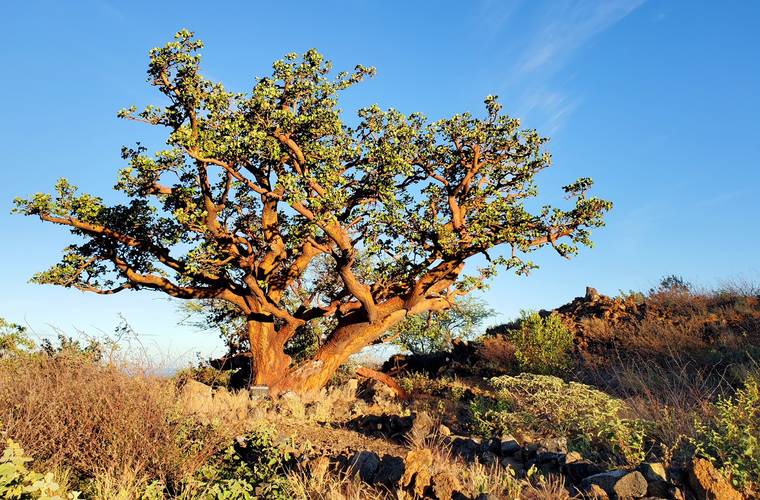Our forests and landscapes can change rapidly.
Hawaii’s endemic Erythrina sandwichensis, or wiliwili, is a colorful flowering tree of the dryland forests, and is vulnerable to threats such as feral pigs, goats, insects and diseases. According to Jen Lawson, executive director of the Waikoloa Dry Forest Initiative, the group is responsible for protecting a 275-acre tract, where rare and endangered shrubs and trees are safe from wild goats and other grazing animals.
Normally there would be an opportunity to visit this little known piece of our paradise as part of the Hawaii Island Wiliwili Festival, but because of COVID-19, Jen is encouraging folks to visit the group’s website, https:www.waikoloadryforest/wiliwilifestival/, for a virtual tour and other activities. There will be limited guided tours at the protected site from 8 a.m.-4 p.m. on Feb. 12-13, but with COVID restrictions in place, they are encouraging folks to go virtual.
Get involved in this great environmental endeavor.
Warming weather has created ideal conditions for Myrtle Rust (Austropuccinia psidii) to cause defoliation, dieback and even death of our beloved ohia and many other related species in the Myrtle family. About 150 species are susceptible including Mountain Apple, guava, eucalyptus, callistemon, melaleuca and rhododendron.
What happens as these species die? The answer is other species fill the void, thus altering forests and even our gardens.
What was it like for the first Polynesian pioneers who found these islands? The forests in those earliest days of human activity were very different than today. What is now open grasslands used to be forests. Trees such as loulu palms flourished in abundance, but it wasn’t long afterward that the Polynesian introduction of pigs and rats radically changed things. With the later arrival of herbivores such as goats, sheep and cattle, even more damage was done to the forests.
Today, erosion is also a big problem on most high islands, and the rising ocean is swallowing low atolls that have been the homes of islanders for thousands of years.
Destruction, rebirth and evolution continue to happen as is taught to us by our active volcanoes and climate change. The moral is that we must learn to adapt to change and at the same time keep as many of the good qualities of the past where we can. This remains true as we face the challenges of climate change and population increase causing land use issues.
Our parks and gardens reflect the complicated evolution of life and culture.
We have a wide variety of plants, native and introduced. By keeping the lush vegetation an integral part of our communities, we do our part to fight pollution, global warming and make life more enjoyable.
As individuals, one of the easiest ways to decrease the carbon dioxide levels in the atmosphere is to plant trees. There are a number of trees that can help accomplish this purpose. Among the best are natives such as the loulu palms, ohia, hala, wiliwili, hoawa, alahe‘e and a‘ali‘i.
Other plants, such as the beach and mountain naupaka, are attractive to many birds and also make good ornamentals for a garden. Flowers of the ohia, koa, hau, milo and mamane might even attract some native nectar feeding birds such as iiwi, amakihi, apapane and elepaio.
The hala tree, or Pandanus, is another of interest and beauty. It can be grown from sea level to at least 3,000 feet elevation. It adapts to wet or dry locations. The leaves have been used for walls, floor mats, and thatched roofs. Today, artists weave purses, shopping bags and hats with them.
Another group of plants to consider are those the Polynesians brought with them such as coconut, kukui, Mountain Apple, banana, sugarcane, bamboo and breadfruit.
Remember, even though they will likely be different in the years to come, our gardens can and should reflect the best of the Hawaiian culture.

